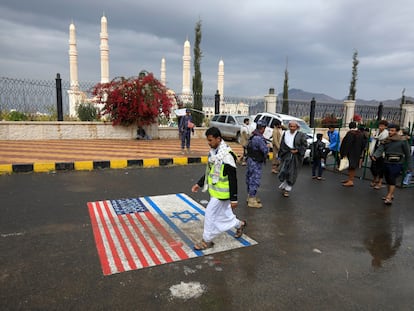25,000 deaths in Gaza: Why the destruction of this war exceeds that of other major conflicts
Eight out of every 10 victims in the Palestinian enclave since last October 7 are women or children
The health authorities in Gaza, under the control of Hamas, on Sunday raised to 25,105 the death toll from Israel’s attacks on the Gaza Strip since October 7. Five out of every 10 victims are minors, three out of 10 are women and two out of 10 are men aged 18 or over. To this figure must be added 62,681 people who have been wounded since the beginning of the bombings.
The figure implies that more than one in every 100 Gazans has died in the 105 days of conflict, just over 1% of the population.
It is difficult to find similar numbers in other recent conflicts. The available data, compiled by the United Nations in the academic project Cost of War, indicate that more people are dying per day in Gaza than in Iraq (even in the worst month of fighting in that country), in Syria or in the first month of war in Ukraine.
Those conflicts lasted longer (the first invasion of Iraq, eight years) and resulted in hundreds of thousands of deaths. The one in Gaza is still at the beginning and there are no signs of it ending in the near future.
This pace has caused the death toll in Gaza to reach 10,000 after just the first month of attacks. In Ukraine, it took a year and a half to reach that number (including civilians only). The following graph shows how death figures evolved in each conflict until the third month of war.
These numbers are explained, in part, because the magnitude of Israel’s attack is unprecedented. There have never been as many airstrikes with civilian casualties in the Middle East conflicts as those that were recorded in October and November in Gaza and the West Bank: 1,614, almost all of them in Gaza, according to data from the Armed Conflict Location and Event Data Project (ACLED).
Israel appears to be applying what is known as the Dahiya Doctrine, so named after a stronghold of the Hezbollah militia in the south of Beirut that Israel bombed intensively after the kidnapping of two of its soldiers that started the 2006 war. Gadi Eizenkot, then the Chief of General Staff and now a member of Israel’s war cabinet, explained it two years later as “using disproportionate force and causing immense damage and destruction” by considering any location from which shots are fired at Israel as “military bases.” In the background is the idea that this tough strategy will lead the population to rebel against Hamas.
A direct consequence of these bombings is the destruction in Gaza. Around half of the buildings in Gaza have been damaged or destroyed, a figure that rises to between 72% and 84% in the north of the Palestinian enclave, according to an analysis based on images from the Copernicus Sentinel-1 satellite.
There were not as many attacks and deaths in previous conflicts between Gaza and Israel, either. The figures recorded this year multiply by 10 the highest levels of previous years. Since reliable data became available (2008), only in 2014 had there been more than 2,000 deaths in the Gaza Strip and the West Bank (and it was over the course of a year).
At the start of the war, military spokesman Daniel Hagari admitted that the “emphasis” of bombing was on damage, not precision. U.S. intelligence services estimate that about half of the munitions Israel has dropped from the air are unguided.
Another difference with previous conflicts lies in the use of artificial intelligence. The previous Chief of the General Staff, Aviv Kojavi, pointed out last year that the new data system generates 100 potential targets daily, when before there were 50 in a year.
No safe zones
Among those killed in Gaza, there is no way to distinguish between Hamas militiamen and civilians, but the death toll has been contrasted and verified in several international scientific studies (such as this one from The Lancet). In addition, there is a very high percentage of women and children, who are unlikely to be militiamen, among the victims.
The figures are partly explained by the demographics of Gaza, where one in two people is underage: it is sadly logical that in an indiscriminate bombing one in two victims would be a child.
Israel’s attacks have not focused only on the north of Gaza, where, at first, the army said it wanted to eradicate Hamas: 25% of the victims died in Rafah and Khan Younis, two towns south of the Wadi Gaza River, where Israeli forces urged the civilian population to take refuge in the first month of the war.
Gazan authorities, who are publishing a list with the names, surnames and ID of the deceased, also estimate that there are about 7,000 people under the rubble. The situation makes it difficult to estimate deaths due to lack of medical care (more than 62,000 injuries have been recorded), hunger (most people can hope for no more than one meal a day) or illnesses caused by sleeping in tents in the coldest months of the year.
Sign up for our weekly newsletter to get more English-language news coverage from EL PAÍS USA Edition.

